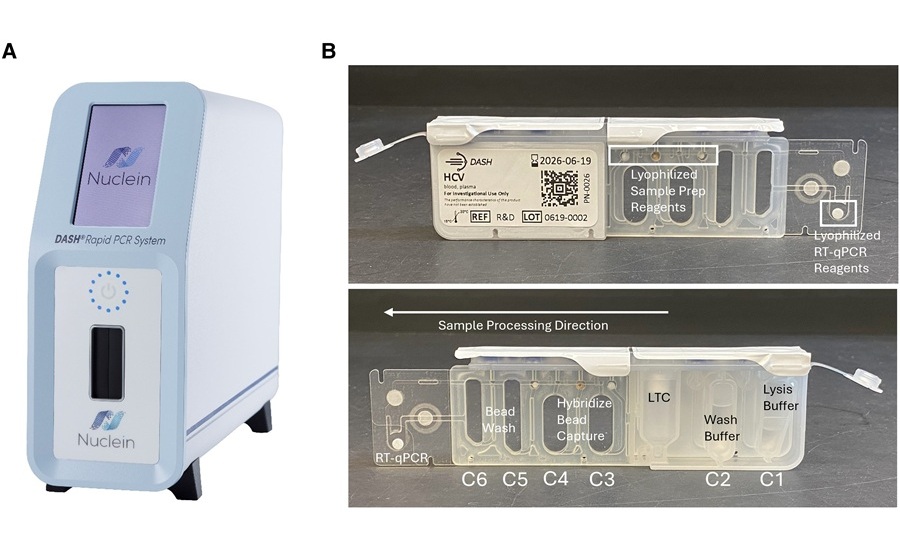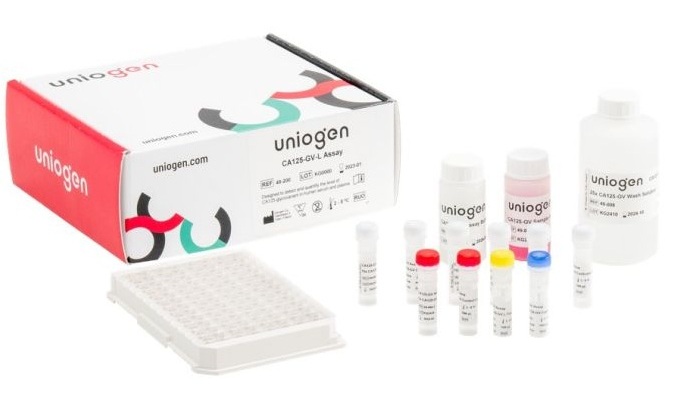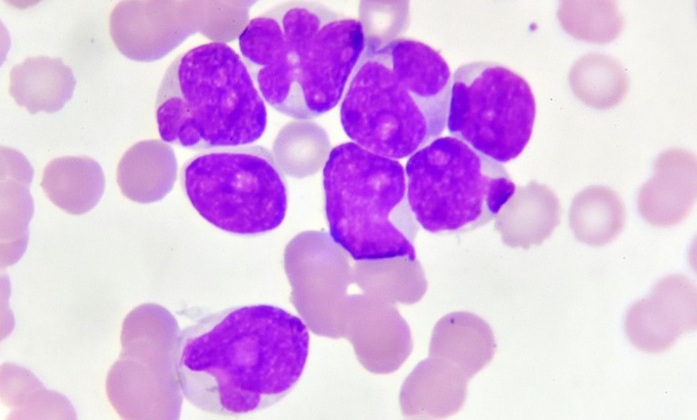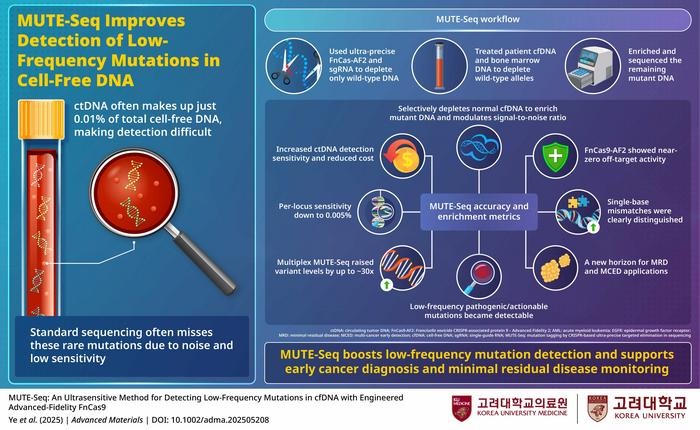Loss of MicroRNA Induces Pro-Metastatic Changes in Pancreatic Cancer Cells
|
By LabMedica International staff writers Posted on 14 Jun 2016 |

Image: A pancreatic cancer cell. The nucleus is stained blue, while the fibers of the cytoskeleton are labelled with a red fluorescent dye (Photo courtesy of Dr. Nathalie Giese, Chirurgische Universitätsklinik Heidelberg, Germany).
Reduced activity of a specific microRNA (miRNA) is apparent in chronically inflamed pancreatic tissue and in early stages of pancreatic cancer (pancreatic ductal adenocarcinoma or PDAC) even before tumor formation.
PDAC is characterized by very early metastasis, which has led some researchers to postulate that metastasis-associated changes may occur prior to actual tumor formation. To confirm this hypothesis investigators at the German Cancer Research Center (Heidelberg, Germany) analyzed levels of miRNAs known to be linked to PDAC.
MicroRNAs are a class of about 20 nucleotides-long RNA fragments that block gene expression by attaching to molecules of messenger RNA in a fashion that prevents them from transmitting the protein synthesizing instructions they had received from the DNA. With their capacity to fine-tune protein expression via sequence-specific interactions, miRNAs help regulate cell maintenance and differentiation.
The investigators reported in the May 23, 2016, online edition of the journal Cancer Research that they had identified the microRNA miR-192 as an epigenetically regulated suppressor gene with predictive value in PDAC. Levels of miR-192 were downregulated by promoter methylation in both PDAC and chronic pancreatitis (CP), a risk factor that leads to a 15-fold increase in the likelihood of contracting pancreatic cancer.
Functional studies in vitro and in mouse models of PDAC showed that overexpression of miR-192 was sufficient to reduce cell proliferation and invasion. Mechanistic analyses correlated changes in miR-192 promoter methylation and expression with epithelial-mesenchymal transition (EMT).
Cell proliferation and invasion were linked to altered expression of the miR-192 target gene SERPINE1, which encodes the protein plasminogen activator inhibitor-1 (PAI-1), an established regulator of these properties in PDAC cells. These results suggested that miR-192 downregulation established an invasive capacity in these pancreatic cells even before they transformed into cancer cells.
"We think that the cells often already have metastatic capacity before even transforming into cancer cells," said senior author Dr. Jörg Hoheisel, head of the division of functional genome analysis at the German Cancer Research Center. "To check this hypothesis, we searched the tumor cells for molecular changes that are indicative of the tendency to spread early. Our interpretation of these results is that epigenetic changes that occur already in inflamed pancreatic tissue lead to reduced production of miR-192. This means that the cells acquire the capacity of invasion and metastasis, which initially has no consequences. The actual transformation into cancer cells is caused by other, unrelated factors and can occur later. The result is cancer cells that are capable, from the very start, to invade surrounding tissue and spread metastases."
Related Links:
German Cancer Research Center
PDAC is characterized by very early metastasis, which has led some researchers to postulate that metastasis-associated changes may occur prior to actual tumor formation. To confirm this hypothesis investigators at the German Cancer Research Center (Heidelberg, Germany) analyzed levels of miRNAs known to be linked to PDAC.
MicroRNAs are a class of about 20 nucleotides-long RNA fragments that block gene expression by attaching to molecules of messenger RNA in a fashion that prevents them from transmitting the protein synthesizing instructions they had received from the DNA. With their capacity to fine-tune protein expression via sequence-specific interactions, miRNAs help regulate cell maintenance and differentiation.
The investigators reported in the May 23, 2016, online edition of the journal Cancer Research that they had identified the microRNA miR-192 as an epigenetically regulated suppressor gene with predictive value in PDAC. Levels of miR-192 were downregulated by promoter methylation in both PDAC and chronic pancreatitis (CP), a risk factor that leads to a 15-fold increase in the likelihood of contracting pancreatic cancer.
Functional studies in vitro and in mouse models of PDAC showed that overexpression of miR-192 was sufficient to reduce cell proliferation and invasion. Mechanistic analyses correlated changes in miR-192 promoter methylation and expression with epithelial-mesenchymal transition (EMT).
Cell proliferation and invasion were linked to altered expression of the miR-192 target gene SERPINE1, which encodes the protein plasminogen activator inhibitor-1 (PAI-1), an established regulator of these properties in PDAC cells. These results suggested that miR-192 downregulation established an invasive capacity in these pancreatic cells even before they transformed into cancer cells.
"We think that the cells often already have metastatic capacity before even transforming into cancer cells," said senior author Dr. Jörg Hoheisel, head of the division of functional genome analysis at the German Cancer Research Center. "To check this hypothesis, we searched the tumor cells for molecular changes that are indicative of the tendency to spread early. Our interpretation of these results is that epigenetic changes that occur already in inflamed pancreatic tissue lead to reduced production of miR-192. This means that the cells acquire the capacity of invasion and metastasis, which initially has no consequences. The actual transformation into cancer cells is caused by other, unrelated factors and can occur later. The result is cancer cells that are capable, from the very start, to invade surrounding tissue and spread metastases."
Related Links:
German Cancer Research Center
Latest BioResearch News
- Genome Analysis Predicts Likelihood of Neurodisability in Oxygen-Deprived Newborns
- Gene Panel Predicts Disease Progession for Patients with B-cell Lymphoma
- New Method Simplifies Preparation of Tumor Genomic DNA Libraries
- New Tool Developed for Diagnosis of Chronic HBV Infection
- Panel of Genetic Loci Accurately Predicts Risk of Developing Gout
- Disrupted TGFB Signaling Linked to Increased Cancer-Related Bacteria
- Gene Fusion Protein Proposed as Prostate Cancer Biomarker
- NIV Test to Diagnose and Monitor Vascular Complications in Diabetes
- Semen Exosome MicroRNA Proves Biomarker for Prostate Cancer
- Genetic Loci Link Plasma Lipid Levels to CVD Risk
- Newly Identified Gene Network Aids in Early Diagnosis of Autism Spectrum Disorder
- Link Confirmed between Living in Poverty and Developing Diseases
- Genomic Study Identifies Kidney Disease Loci in Type I Diabetes Patients
- Liquid Biopsy More Effective for Analyzing Tumor Drug Resistance Mutations
- New Liquid Biopsy Assay Reveals Host-Pathogen Interactions
- Method Developed for Enriching Trophoblast Population in Samples
Channels
Clinical Chemistry
view channel
Online Tool Detects Drug Exposure Directly from Patient Samples
Doctors often rely on patient interviews and medical records to determine what medications a person has taken, but this information is frequently incomplete. People may forget drugs they used, take over-the-counter... Read more
Chemical Imaging Probe Could Track and Treat Prostate Cancer
Prostate cancer remains a leading cause of illness and death among men, with many patients eventually developing resistance to standard hormone-blocking therapies. These drugs often lose effectiveness... Read moreMolecular Diagnostics
view channel
New 15-Minute Hepatitis C Test Paves Way for Same-Day Treatment
Chronic hepatitis C infection affects an estimated 50 million people worldwide and causes around 242,000 deaths each year, largely due to cirrhosis and liver cancer. Although the infection is curable with... Read more
Ovarian Cancer Assay Outperforms Traditional Tests in Early Disease Detection
Globally, ovarian cancer is one of the deadliest cancers affecting women. Traditionally, early diagnosis of ovarian cancer has been challenging. Many ovarian cancers are diagnosed only after they have... Read moreHematology
view channel
MRD Tests Could Predict Survival in Leukemia Patients
Acute myeloid leukemia is an aggressive blood cancer that disrupts normal blood cell production and often relapses even after intensive treatment. Clinicians currently lack early, reliable markers to predict... Read more
Platelet Activity Blood Test in Middle Age Could Identify Early Alzheimer’s Risk
Early detection of Alzheimer’s disease remains one of the biggest unmet needs in neurology, particularly because the biological changes underlying the disorder begin decades before memory symptoms appear.... Read more
Microvesicles Measurement Could Detect Vascular Injury in Sickle Cell Disease Patients
Assessing disease severity in sickle cell disease (SCD) remains challenging, especially when trying to predict hemolysis, vascular injury, and risk of complications such as vaso-occlusive crises.... Read more
ADLM’s New Coagulation Testing Guidance to Improve Care for Patients on Blood Thinners
Direct oral anticoagulants (DOACs) are one of the most common types of blood thinners. Patients take them to prevent a host of complications that could arise from blood clotting, including stroke, deep... Read moreImmunology
view channel
Routine Blood Test Can Predict Who Benefits Most from CAR T-Cell Therapy
CAR T-cell therapy has transformed treatment for patients with relapsed or treatment-resistant non-Hodgkin lymphoma, but many patients eventually relapse despite an initial response. Clinicians currently... Read more
New Test Distinguishes Vaccine-Induced False Positives from Active HIV Infection
Since HIV was identified in 1983, more than 91 million people have contracted the virus, and over 44 million have died from related causes. Today, nearly 40 million individuals worldwide live with HIV-1,... Read more
Gene Signature Test Predicts Response to Key Breast Cancer Treatment
DK4/6 inhibitors paired with hormone therapy have become a cornerstone treatment for advanced HR+/HER2– breast cancer, slowing tumor growth by blocking key proteins that drive cell division.... Read more
Chip Captures Cancer Cells from Blood to Help Select Right Breast Cancer Treatment
Ductal carcinoma in situ (DCIS) accounts for about a quarter of all breast cancer cases and generally carries a good prognosis. This non-invasive form of the disease may or may not become life-threatening.... Read moreMicrobiology
view channel
Blood-Based Diagnostic Method Could Identify Pediatric LRTIs
Lower-respiratory tract infections (LRTIs) are a leading cause of illness and death worldwide, and pneumonia is the leading infectious cause of death in children under five, claiming the lives of over... Read more
Rapid Diagnostic Test Matches Gold Standard for Sepsis Detection
Sepsis kills 11 million people worldwide every year and generates massive healthcare costs. In the USA and Europe alone, sepsis accounts for USD 100 billion in annual hospitalization expenses.... Read moreRapid POC Tuberculosis Test Provides Results Within 15 Minutes
Tuberculosis remains one of the world’s deadliest infectious diseases, and reducing new cases depends on identifying individuals with latent infection before it progresses. Current diagnostic tools often... Read more
Rapid Assay Identifies Bloodstream Infection Pathogens Directly from Patient Samples
Bloodstream infections in sepsis progress quickly and demand rapid, precise diagnosis. Current blood-culture methods often take one to five days to identify the pathogen, leaving clinicians to treat blindly... Read morePathology
view channel
Rapid Low-Cost Tests Can Prevent Child Deaths from Contaminated Medicinal Syrups
Medicinal syrups contaminated with toxic chemicals have caused the deaths of hundreds of children worldwide, exposing a critical gap in how these products are tested before reaching patients.... Read more
Tumor Signals in Saliva and Blood Enable Non-Invasive Monitoring of Head and Neck Cancer
Head and neck cancers are among the most aggressive malignancies worldwide, with nearly 900,000 new cases diagnosed each year. Monitoring these cancers for recurrence or relapse typically relies on tissue... Read more
Common Health Issues Can Influence New Blood Tests for Alzheimer’s Disease
Blood-based tests for Alzheimer’s disease are transforming diagnosis by offering a simpler alternative to spinal taps and brain imaging. However, many people evaluated at memory clinics also live with... Read more
Blood Test Formula Identifies Chronic Liver Disease Patients with Higher Cancer Risk
Chronic liver disease affects millions worldwide and can progress silently to hepatocellular carcinoma (HCC), one of the deadliest cancers globally. While surveillance guidelines exist for patients with... Read moreTechnology
view channel
Machine Learning Models Diagnose ALS Earlier Through Blood Biomarkers
Amyotrophic lateral sclerosis (ALS) is a rapidly progressive neurodegenerative disease that is notoriously difficult to diagnose in its early stages. Early symptoms often overlap with other neurological... Read more
Artificial Intelligence Model Could Accelerate Rare Disease Diagnosis
Identifying which genetic variants actually cause disease remains one of the biggest challenges in genomic medicine. Each person carries tens of thousands of DNA changes, yet only a few meaningfully alter... Read moreIndustry
view channel
Abbott Acquires Cancer-Screening Company Exact Sciences
Abbott (Abbott Park, IL, USA) has entered into a definitive agreement to acquire Exact Sciences (Madison, WI, USA), enabling it to enter and lead in fast-growing cancer diagnostics segments.... Read more



















